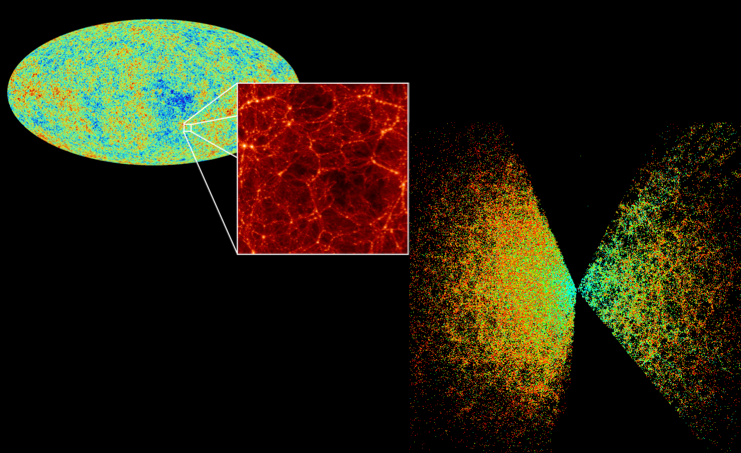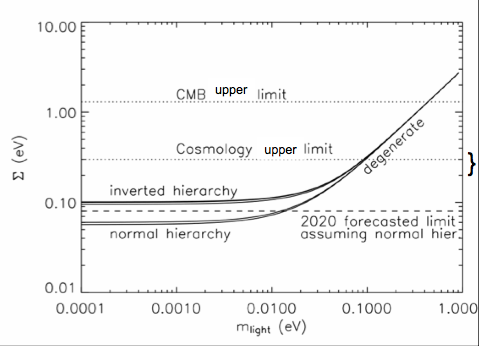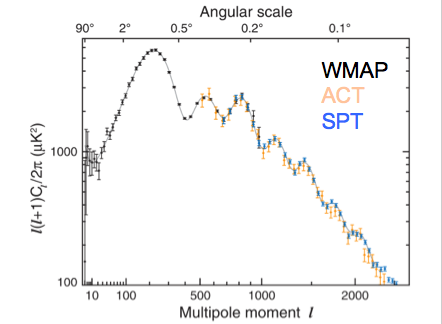Neutrino properties from cosmology
Cosmology has entered the precision era: we now have a standard model for cosmology where the content, history and evolution of the Universe are described by few parameters. These parameters are constrained by observations at the percent level or better.
As for particle physics and the search for beyond the standard model, the next development is to test for possible deviations from the standard model like for example constraining neutrino properties. In the standard cosmological model there are three massless neutrinos. Oscillations experiments however have indicated that neutrinos have non-zero mass and therefore this is a promising avenue to explore. This is the reason why there is much interest in this and groups (including my own and people here at CERN) are actively working on it.
Before going one a couple of remarks are in order. First, in cosmology we can't do experiments only observations: we interpret observations in the framework of a given model. Thus unavoidably all constraints are model-dependent. Most analyses allow one extra parameter at the time to describe deviations from the standard model.
Second, for cosmology neutrinos are: a component of the Universe that behaves like radiation all the way to recombination (at least), eventually it can become non-relativistic and behave like matter, it has small interaction and has a high velocity dispersion (i.e. it behaves like hot dark matter).
In the standard big bang model there should be a cosmic neutrino background, similar to the Cosmic Microwave Background (CMB) but that decouples from matter when the Universe was about 2 s old (not 380,000 years). These are the neutrinos that were discussed in the recent CERN Colloquium.
Neutrinos influence cosmology in several ways: when the temperature of the Universe was of the order of MeV they affect primordial nucleosynthesis as the number of effective neutrinos species affect the amount of radiation and therefore the expansion rate of the Universe (the photons density is extremely well determined via the CMB temperature).
It is however important to keep in mind that anything that behaves like radiation before recombination can be described by the effective number of neutrino species parameter!
When the Universe temperature is below the eV, then neutrinos affect both the Cosmic Microwave Background (CMB) and the large-scale structure.
The effective number of species, by affecting the expansion rate, changes matter radiation equality and thus affects the shape of the CMB angular power spectrum (both the peak locations and the damping tail). This parameter does not affect directly the late-time universe, but such observations can be used to break degeneracies and get tighter constraints.

Fig 1. Neutrino properties affect cosmological observables such as the statistics of the Cosmic Microwave Background (top left, data form the WMAP satellite) the clustering of dark matter (inset, for N-body simulations) and therefore the clustering of galaxies at low redshift (right, data from the Sloan Digital Sky Survey). See also: WMAP: http://map.gsfc.nasa.gov and Sloan Digital Sky Survey: http://www.sdss.org
The current situation on the cosmological determination of the number of effective neutrino species is somewhat confused: most analyses tend to find a 1.5-2sigma tendency for this number to be greater than 3. However these analyses are not independent (the CMB data and the Hubble constant determinations are almost aways in common), and tend to combine many different data-sets. The errors in any single data-set are composed by statistical and systematic errors where the systematics are hopefully smaller than the statistical ones. When combining many data sets, all errors are treated as statistical, while we do know very well that statistical errors shrinks but systematics do not. Some see the bottle half full and claim that cosmology supports sterile neutrinos, others (including myself) see the bottle half empty and consider that cosmology is well consistent with the standard number of neutrino families and there is no reason to worry about sterile neutrinos, at leads not yet, not looking at cosmological data.

Fig 2: Overview of the constraints in neutrino masses: the solid lines show the constrains from oscillations. The dotted horizontal lines show the cosmology constraints (cosmology constrains the total mass) and the dashed horizontal line shows the forecasted limit for cosmological data that will (if all goes according to plans) be available in 2020. The bracket on the right hand side shows the forecasted constraints (in the next year or so) from the Katrin experiment. Read more about Katrin: http://www.katrin.kit.edu/68.php
Non-zero neutrino masses also affect cosmological observables. A total neutrino mass above about one eV becomes non-relativistic before recombination and thus it can be constrained with CMB observations. A smaller total mass still affects the CMB but its effect is degenerate with that of other cosmological parameters (indeed the latest constraints from the CMB are that the sum of the masses is below 1.3 eV at 95% confidence-- WMAP9 Hinshaw et al 2012). However, after recombination finite neutrino masses suppress the matter power spectrum on scales smaller than the free streaming length. This opens up the possibility to detect neutrino masses by measuring the matter power spectrum from observations of large-scale structures (i.e. galaxy surveys and/or weak gravitational lensing surveys). Different analysis have been performed on currently available data and most converge on a limit for the sum of the masses of 0.3eV at the 95% confidence (assuming 3 standard families). There has been a recent claim of detection of non-zero mass at the 0.3eV level (by the South Pole telescope team when their data are combined with other data sets), which is interesting as it could be soon validated (or not) by the Katrin experiment. But I feel that the claim is too fresh and has not yet been scrutinized deeply enough by the community to warrant including it e.g., in the Particle Data Group review.

Fig 3: CMB angular power spectrum (state of the art until 12.00pm Thursday 21 March) Black: WWMAP data. Yellow: Atacama Cosmology Telescope data (ACT),Bue: South Pole telescope data (SPT).See also: ACT: http://www.princeton.edu/act/ and SPT: http://pole.uchicago.edu.
More importantly, the forecasted sensitivity of future surveys should be enough to detect a total neutrino mass at the lower limit imposed by the oscillations constraints (0.05eV). This is what makes this really exciting as cosmology may be the way to measure the absolute neutrino mass scale.
Of course, by relying on observations of the late-time non-linear Universe, such measurements might be affected by systematic errors coming mainly from our limited ability to model the non-linear Universe and a lot of effort is being devoted to quantify and ameliorate this.
There is however in principle also the possibility of using the CMB as backlight illumination of the entire growth of cosmic structure: cosmological structures along the line of sight gravitationally lens the CMB sky. This lensing signature can be used to reconstruct the statistical properties of the intervening dark matter and thus "see" the effect of neutrino masses. This approach is still in its infancy, as the effect has just been detected for the first time over the past couple of years, but it is extremely promising offering a powerful consistency check of any detection of neutrino mass done with the direct observations of the late time Universe.
All analysis mentioned so far assume degenerate neutrino species, as current data do not have the statistical power to see any effect of the mass splitting. However, neutrinos of different masses become non-relativistic a slightly different times, so in principle cosmology can yield information about the neutrino mass hierarchy. This is very challenging and will require a very ambitious survey, but the signature of mass hierarchy could be used as a powerful consistency check for the cosmological measurement of the mass, as it turns out, for a given total mass oscillations experiments give precise predictions for the effect of mass splitting on cosmological clustering.
In summary, precision cosmology means that we can start (or prepare for) constraining interesting physical quantities from observations of the sky, and neutrino properties are a particularly hot avenue to pursue. Precision measurement of neutrino properties (mass, and possibly mass splitting/hierarchy) means measuring sub % effects on statistical quantities like the matter power spectrum, which brings in a whole new set of challenges and opportunities.
Licia Verde is ICREA professor at ICC University of Barcelona (ES) & IEEC. Licia is spending a sabbatical year at CERN 2012/2013. She is originally from Venice (IT) obtained her PhD from the University of Edinburgh (UK) and held positions at Rutgers, Prinecton and University of Pennsilvanya (USA).
You can watch the full video by clicking here
